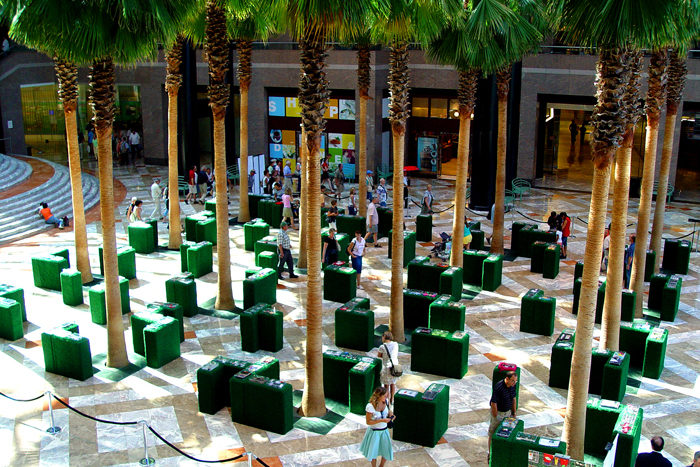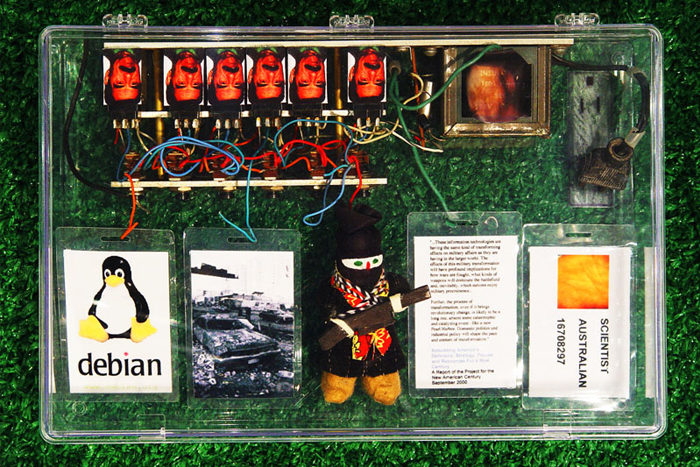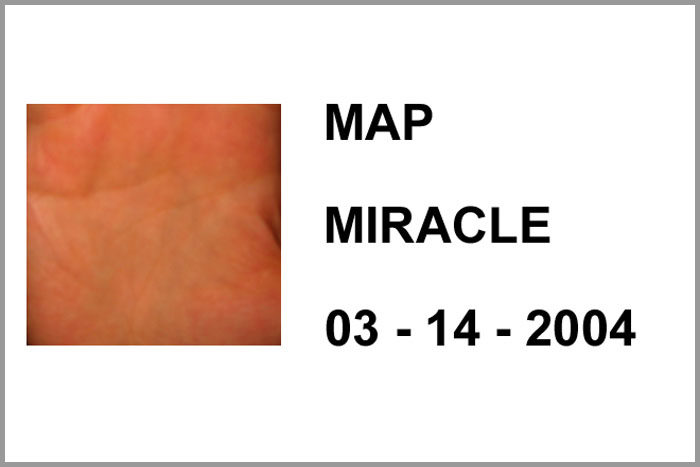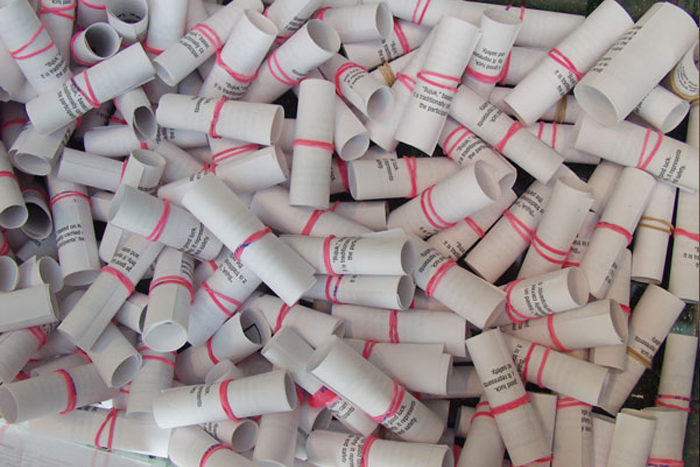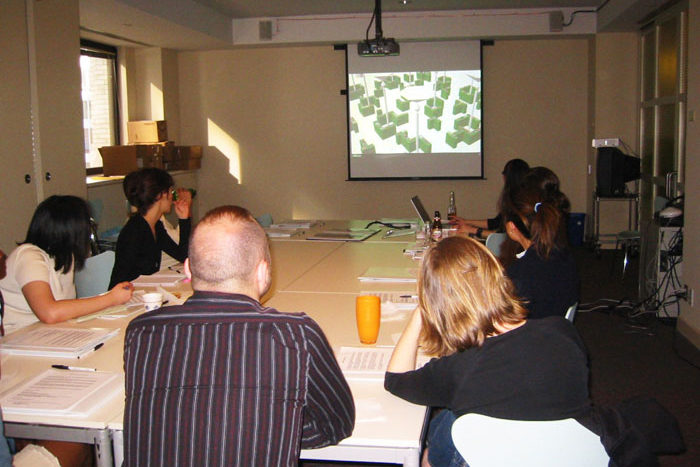The World Financial Center Winter Garden in New York City, September, 2005
in conjunction with The Lower Manhattan Cultural Council’s “What Comes After: Cities, Art and Recovery”
200 “Emergency Kits” in the Maze
3 ft (H) x 50 ft (W) x 60 ft (D)
HOMELAND SECURITY GARDEN, a public art project presented at The World Financial Center Winter Garden, investigates our political and psychological in/security in the post 9/11 world.
During World War II, in America and England, people helped prepare for critical times by growing “victory gardens” which helped take the strain off war-taxed economies by making families self sufficient. Each family chose for themselves the things they saw as the most important staples to have. In the 1950s in America there was a huge fear of nuclear war and a sense of need to prepare for the possible crisis. The past decade saw a lull in these fears, but in the current global political climate, people are suffering from renewed concerns of terror, safety, and the need to be prepared.
The recently formed “Bureau of Homeland Security” in the U. S. addresses these issues, but along with the stress on readiness has come a new surveillance economy and a potential loss of personal freedom and the safety to express alternative views. Times of crisis can pit the forces of homogenization and unified doctrine against cherished values such as tolerance for a multiplicity of views and beliefs.
HOMELAND SECURITY GARDEN explores the complex issues of safety, security and personal freedom in times of crisis. Workshops related to creation of the artwork were conducted all over New York City, with individuals from many different ethnic and socioeconomic backgrounds, including people from Asian, Muslim, African American, Jewish and Latino communities. 200 participants donated mundane items that relate to personal notions of safety. There were no rules regarding what could and could not be donated, as long as it could fit within a 9″ x 13″ x 2 1/4″ cardboard box.
Rather than simply laying out or arranging the contributed items, the artist made an artwork about each of the people involved in the project. The artist worked individually with the raw materials contributed by each participant. After reviewing the materials and based on interviews conducted, the artist proceeded to envision and create a safety kit artwork which reflected the qualities of each particular individual. At times a number of the contributed items were used. At other times the artist would use only a single item as the base for the artwork or in some instances none of the items were used directly, but ideas from the items became the basis for the particular artwork about that person.
Each of these small individual artworks or “Emergency Kits” are then displayed together as a single unified art installation in the form of a giant maze or garden. The 200 kits sit on three foot high Astroturf-covered pedestals that are arranged like a 19th century horticultural maze. The garden evokes a traditional sense of home and place while the maze layout represents the difficulties of navigating the world’s current complexities. The entire exhibit filled most of the floor of the World Financial Center Winter Garden.
Choosing personal items for a safety kit forces one to question, on a deep level, what one considers most valuable. What people need or consider most important varies by ethnic, social, and economic background. These differences are highlighted and celebrated in this project.
Taking an experimental approach to content and form, the installation invites viewers to re-exam the feelings and desires we all have regarding emergency and personal freedom. This project challenges the boundaries between the art world and everyday life while examining the cultural and political complexity of our time.
HOMELAND SECURITY GARDEN promotes exploration through presentation of a varied yet collective voice. It brings up the issues of freedom of speech, individual security/insecurity, how culturally defined notions of value and need vary by society and economic status, while at the same time providing a voice for individual expression. Ultimately, it is a celebration of a multitude of varying individual voices – what freedom and democracy is based on.
Press:
“Social security” Time Out NY, 2005
“Homeland Security Garden” Public Art Review, 2006
“A post 9-11 comfort zone” Daily News, 2005
“Near Ground Zero, security is given artistic expression” Metro, 2005
“Homeland Security Garden Exhibits Examines What Make People Feel Safe” NY1, 2005
“우리를 안전하게 만드는 것들…” 중앙일보, The Korea Daily, 2005
Special thanks to the following for thier invaluable support for this project.
The World Financial Center Arts & Events:
Debra Simon, Karen Kitchen, Shannon Mayers, Bruce Cohen, Miguel Lopez, Allan Abrams, Melissa Cohen, LaToya Bennett
The Lower Manhattan Cultural Council:
Tom Healy, Erin Donnelly, Brenda Cho, Janis Astor Del Valle, Radhika Subramaniam, Sara Fang, Perry Garvin, Olga Martins, Mark Vevle, Steffani Jemison
Individuals:
Paul Clay, Sandra Greuel, Angelo Angeles, Susan Juvet, Sun K. Kwak, Ari Hiroshige, Julie Horvath, Carl Watson, Alex Kiefer, Tony Corona, Joyce Chan, Susan Fleminger, AnaMaria Correa, Martin Dust, Reshma Baig, Marcy Brafman, Amy Goldrich, Janet Clancy, Joan Walrich, Shelly Mcguinness, William Dao, Anne Beffel, Heng-Gil Han, Chris Jordan
This exhibit is presented by The World Financial Center Arts & Events, in conjunction with The Lower Manhattan Cultural Council’s “WHAT COMES AFTER: CITIES ART AND RECOVERY.”
Additional funding by The Lower Manhattan Cultural Council’s Manhattan Community Arts Fund, The Puffin Foundation, and The Container Store.







